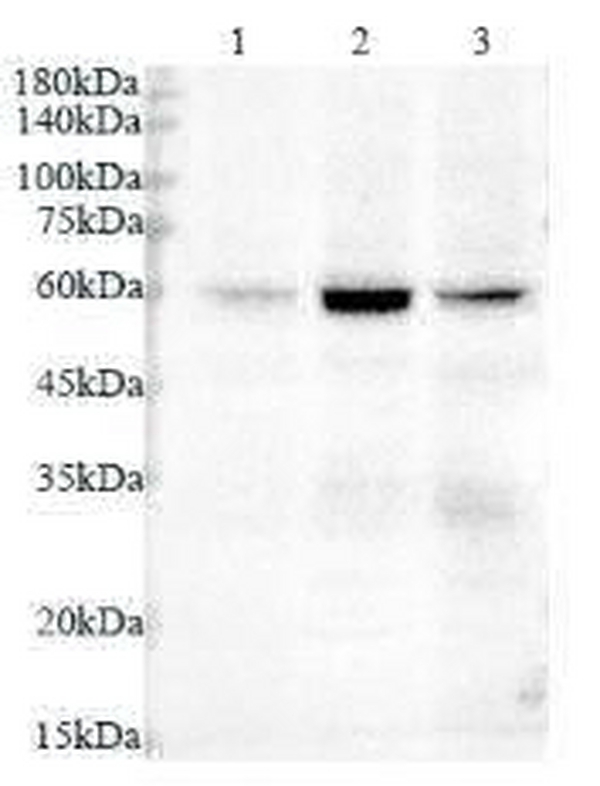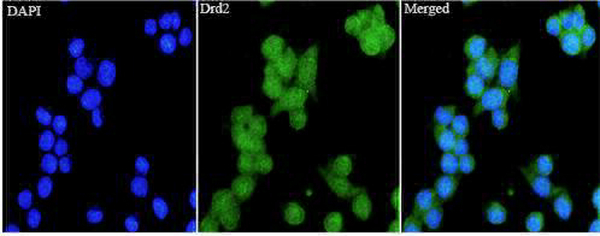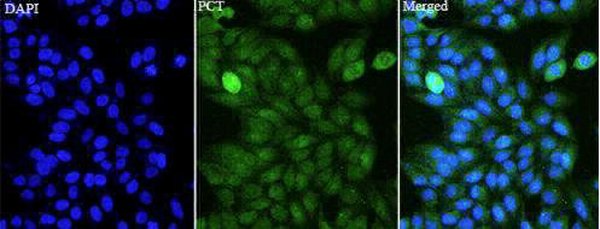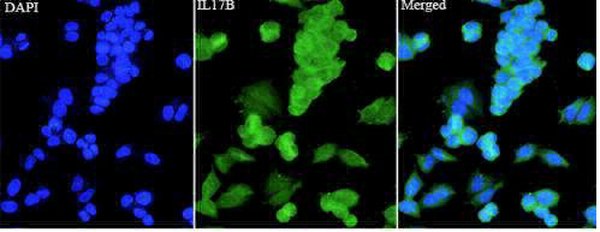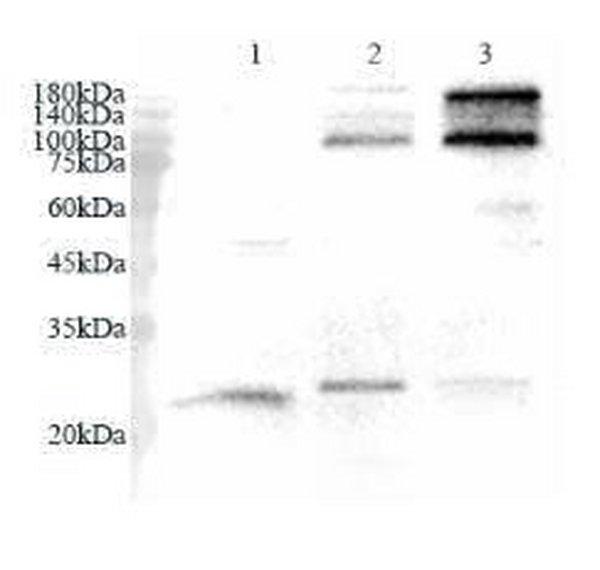QQ:3002763590


客服电话:021-61998208
Anti Drd2 polyclonal antibody
Drd2抗体
Anti Drd2 polyclonal antibodyDRD2, also named as D2DR and D2R, belongs to the G-protein coupled receptor 1 family. It is one of the five types (D1 to D5) of receptors for dopamine. The activity of DRD2 is mediated by G proteins which inhibit adenylyl cyclase. Defects in DRD2 are associated with dystonia type 11 (DYT11). The antibody is specific to DRD2.
Anti TMPRSS2 polyclonal antibody
TMPRSS2抗体
Anti TMPRSS2 polyclonal antibodyTMPRSS2, also named as PRSS10, is a type II transmembrane serine protease which is highly expressed by the epithelium of the human prostate gland. TMPRSS2 may contribute to prostate tumour metastasis via the activation of PAR-2. TMPRSS2 is a Serine protease that proteolytically cleaves and activates the viral spike glycoproteins which facilitate virus-cell membrane fusions. TMPRSS2 as a host cell factor that is critical for spread of several clinically relevant viruses, including influenza A viruses and coronaviruses.SARS-CoV-2 uses the SARS-CoV receptor ACE2 for entry and the serine protease TMPRSS2 for S protein priming. The initial spike protein priming by TMPRSS2 is essential for entry and viral spread of SARS-CoV-2 through interaction with the ACE2 receptor.Camostat mesylate, an inhibitor of TMPRSS2, can block SARS-CoV-2 infection of lung cells.The MW of TMPRSS2 is about 65-70 kDa. It can be cleaved in to some chains with MW 54 kDa, 31 kDa and 26 kD
Anti IL17B polyclonal antibody
IL17B抗体
Anti IL17B polyclonal antibodyThe protein encoded by this gene is a T cell-derived cytokine that shares sequence similarity with IL17. This cytokine was reported to stimulate the release of TNF alpha (TNF) and IL1 beta (IL1B) from a monocytic cell line. Immunohistochemical analysis of several nerve tissues indicated that this cytokine is primarily localized to neuronal cell bodies.
Anti PPL polyclonal antibody
PPL抗体
Anti PPL polyclonal antibodyThe protein encoded by this gene is a component of desmosomes and of the epidermal cornified envelope in keratinocytes. The N-terminal domain of this protein interacts with the plasma membrane and its C-terminus interacts with intermediate filaments. Through its rod domain, this protein forms complexes with envoplakin. This protein may serve as a link between the cornified envelope and desmosomes as well as intermediate filaments. AKT1/PKB, a protein kinase mediating a variety of cell growth and survival signaling processes, is reported to interact with this protein, suggesting a possible role for this protein as a localization signal in AKT1-mediated signaling.
Anti GSTM2 polyclonal antibody
GSTM2抗体
Anti GSTM2 polyclonal antibodyCytosolic and membrane-bound forms of glutathione S-transferase are encoded by two distinct supergene families. At present, eight distinct classes of the soluble cytoplasmic mammalian glutathione S-transferases have been identified: alpha, kappa, mu, omega, pi, sigma, theta and zeta. This gene encodes a glutathione S-transferase that belongs to the mu class. The mu class of enzymes functions in the detoxification of electrophilic compounds, including carcinogens, therapeutic drugs, environmental toxins and products of oxidative stress, by conjugation with glutathione. The genes encoding the mu class of enzymes are organized in a gene cluster on chromosome 1p13.3 and are known to be highly polymorphic. These genetic variations can change an individual's susceptibility to carcinogens and toxins as well as affect the toxicity and efficacy of certain drugs.
Anti PGK1 polyclonal antibody
PGK1抗体
Anti PGK1 polyclonal antibodyThe PGK1 gene encodes phosphoglycerate kinase-1, also known as ATP:3-phosphoglycerate 1-phosphotransferase (EC 2.7.2.3), which catalyzes the reversible conversion of 1,3-diphosphoglycerate to 3-phosphoglycerate during glycolysis, generating one molecule of ATP. It Belongs to the phosphoglycerate kinase family and defects in PGK1 are the cause of phosphoglycerate kinase 1 deficiency (PGK1D). PGK1 has 2 isoforms with the molecular mass of 45 kDa and 41 kDa.
最新动态
-
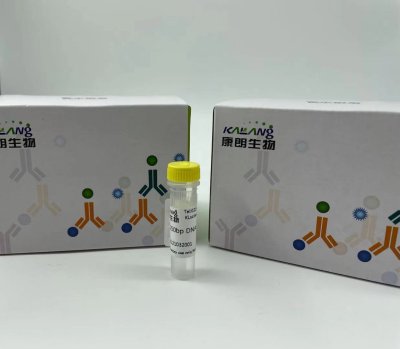
Anti-GNGT1 KL20092-001(50ul)
2021-10-11 -

Anti-GNGT1 antibody(50ul) KL20093-001
2021-10-11 -
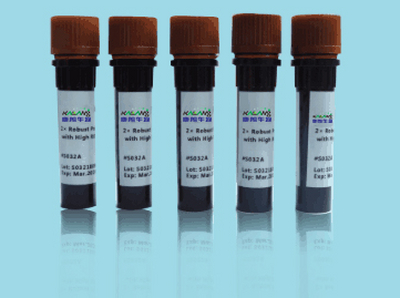
MUC5AC (PT2058) mouse Monoclonal Antibody
2021-01-06 -

mOrange mouse Monoclonal Antibody(Mix)
2021-01-05
热门标签
- Histone H3 rabbit Polyclonal Antibody Histone H3抗体
- EGFR rabbit Polyclonal Antibody EGFR抗体
- Cy3 Conjugated
- AbFluor™ 555 Conjugated
- AbFluor™ 680 Conjugated
- AbFluor™ 350 Conjugated
- AbFluor™ 647 Conjugated
- AbFluor™ 594 Conjugated
- AbFluor™ 405 Conjugated
- Cy5 Conjugated
- AbFluor™ 488 Conjugated
- Cyclophilin B抗体 Cyclophilin B Monoclonal Antibody(2B10)
- COX IV抗体 COX IV Monoclonal Antibody(6C8)
- PCNA抗体 PCNA Monoclonal Antibody(12D10)
- FAK rabbit Polyclonal Antibody FAK抗体
邮箱:3002763590@qq.com
电话:021-61998208

扫码关注微信公众号



